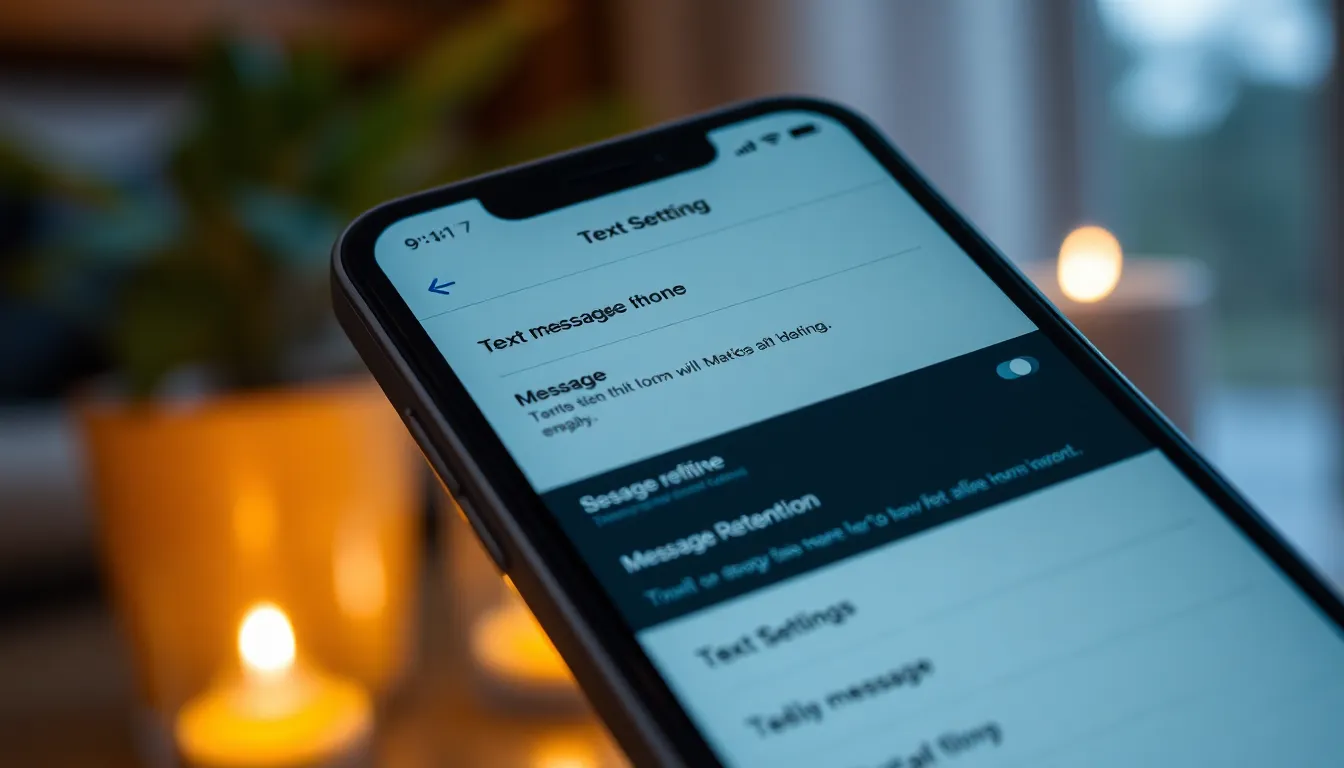Table of Contents
ToggleEver find yourself scrolling through your iPhone messages like you’re on a treasure hunt, only to realize your ancient texts have mysteriously vanished? You’re not alone! Many users wonder if their trusty devices have a secret mission to delete old messages. Spoiler alert: they might just be on a cleaning spree!
In a world where digital clutter can feel overwhelming, it’s crucial to understand how iPhones handle those nostalgic conversations. Whether it’s a cringe-worthy text from high school or a heartfelt message from a loved one, knowing what happens to old messages can save you from unwanted surprises. Let’s dive into the quirky world of iPhone messaging and uncover the truth behind those disappearing texts.
Overview of Message Deletion on iPhone
iPhones do not automatically delete old messages unless configured to do so. Users can manage message settings to retain texts for a specific period or delete them manually. Retention settings include options for keeping messages for 30 days, one year, or indefinitely.
The Messages app allows adjustments under Settings, where users can select the desired duration for message storage. With a default setting of “Keep Messages” on “Forever,” users may inadvertently miss the fact that their messages can delete if altered.
Old messages often disappear due to storage limitations, especially on devices with lower capacity. iPhones can automatically remove the oldest messages once storage reaches critical levels, prioritizing newer data instead.
Moreover, if users opt for regular backups, these backups generally do not retain texts deleted before the backup occurred. Cloud services like iCloud focus on synchronization, potentially leading to the loss of messages if they are deleted on the device before the backup updates.
Notifications regarding message deletions might not always be apparent to users. Hence, awareness of settings, storage capacity, and backup schedules plays an essential role in retaining important conversations. Understanding these factors clarifies how iPhones manage texts, ensuring users remain informed about their message history.
Understanding iPhone Message Settings

iPhones offer various settings for managing text messages, which can impact how and when old messages are deleted. Knowing these settings helps users maintain important conversations.
Default Message Retention
The default message retention setting on iPhones is “Forever.” By choosing this option, users keep all their text messages unless they manually delete them. This setting allows for easy access to old conversations, which may hold sentimental value. However, even with this default setting, messages can disappear if the device experiences storage constraints. Without adequate storage space, an iPhone may prioritize storing new messages, leading to the loss of older texts.
User-Defined Settings
Users can customize their message retention preferences. Options include retaining messages for 30 days, one year, or permanently. Selecting a shorter retention period leads to automatic deletion of older texts when the specified time frame elapses. This flexibility enables users to manage their message storage efficiently while considering personal needs. Users also need to check the settings frequently, as changes may go unnoticed, impacting the messages stored on their device.
Common Misconceptions
Understanding how iPhones manage messages often leads to misconceptions about automatic deletions. Many users assume that older messages disappear without their intervention, creating unnecessary anxiety.
Myths About Automatic Deletion
One prevalent myth suggests iPhones automatically delete old messages after a certain time. In reality, messages only delete if users set their preferences to a specific retention period. The default setting allows messages to persist indefinitely, debunking the idea of automatic purging. Others believe the device prioritizes message deletion over user choice, but this isn’t the case. Messages vanish primarily due to storage constraints, not because of an arbitrary deletion policy. Users can easily check their settings to clarify how their devices handle message retention.
User Experiences and Anecdotes
User experiences vary regarding message retention on iPhones. Some individuals share stories of losing important texts without understanding why. These accounts often stem from low storage situations, where users didn’t realize their iPhones manage older conversations based on available space. Others recount positive experiences where their cherished messages remain safe because they utilized the “Keep Messages” setting to ensure preservation. Confusion tends to arise when users overlook backup practices, leading to lost texts they assumed were secure. Overall, awareness of settings and storage usage plays a crucial role in managing messages effectively.
What Happens to Old Messages?
Old messages on iPhones may not persist if storage gets tight. Storage management plays a vital role in how iPhones handle text messages.
Storage Management on iPhones
iPhones prioritize newer data when storage runs low. When this happens, older messages might get deleted, leaving users confused. Users can check their device’s available storage by navigating to Settings, tapping on General, and then selecting iPhone Storage. The default setting for message retention is “Forever,” meaning texts remain until manually deleted. Users not wanting to lose cherished conversations should monitor their storage levels regularly. Changing settings to maintain texts for 30 days or a year results in automatic deletions. Keeping the default setting maximizes the chance of preserving important communications.
Retrieval of Deleted Messages
Recovering deleted messages on an iPhone isn’t always straightforward. iCloud backups may not restore texts deleted before the backup occurs. Users utilizing iCloud must ensure their messages are included during backup settings. Software tools are available that may help retrieve lost messages, but success is not guaranteed. Turning on iCloud Message syncing maintains backups of conversations across devices. To improve the likelihood of recovery, regularly back up the device, ensuring all important messages are saved. Understanding the implications of message deletion can aid users in managing their text history effectively.
Understanding how iPhones manage old messages can help users avoid losing valuable conversations. While iPhones don’t automatically delete texts, users must be mindful of their settings and storage capacity. Regularly checking these settings ensures important messages are retained and not lost due to low storage.
Users should also remember that backups may not recover texts deleted prior to the last backup. By staying informed about message retention options and utilizing tools like iCloud, they can better protect their cherished communications. Awareness and proactive management are key to preserving memories within the messaging app.




